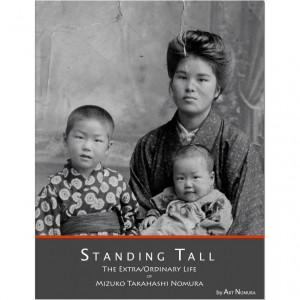When the Japanese Canadian newspaper Nikkei Voice asked me to write about my favorite recent books related to Japan, I realized that I’ve read some books in the past year that I never got around to writing about, and was also finishing an innovative new book, or to be precise, a new ebook.
In any case, I tend to read many more non-fiction books by and about Japan and Japanese Americans than I do any fiction titles, so it’s sort of surprising to me that two of these books are flat-out fiction (albeit based on the author’s childhood for “Kazuo’s World”) and that another is fiction manga based on history and another is history told through a fictionalized manga lens.
Standing Tall: The Extra/Ordinary Life of Mizuko Takahashi Nomura
 The most recent book I’ve read is “Standing Tall: The Extra/Ordinary Life of Mizuko Takahashi Nomura,” by Sansei artist, filmmaker and film professor Art Nomura. It’s a biography of Nomura’s grandmother, who immigrated to the U.S. in the early 1900s, made as an interactive iBook for iPads, iPhones and Macs. The family history is well written but what makes it special is the chockfull of extra information, side stories, games, clickable images and links to other resources that Nomura includes. The book is a fascinating, well-researched read — though Nomura admits he’s made up conversations and details of his grandmother’s early days in Japan, it’s as detailed and factual as possible. It’s certainly a great look at one Issei woman’s epic life, and the experience is made that much richer with all the extra information Nomura adds, utilizing the iBook format to its fullest. The downside of being on the cutting edge, of course, is that unless you have a Mac computer, an iPad or an iPhone, you won’t be able to read this delightful loving biography.
The most recent book I’ve read is “Standing Tall: The Extra/Ordinary Life of Mizuko Takahashi Nomura,” by Sansei artist, filmmaker and film professor Art Nomura. It’s a biography of Nomura’s grandmother, who immigrated to the U.S. in the early 1900s, made as an interactive iBook for iPads, iPhones and Macs. The family history is well written but what makes it special is the chockfull of extra information, side stories, games, clickable images and links to other resources that Nomura includes. The book is a fascinating, well-researched read — though Nomura admits he’s made up conversations and details of his grandmother’s early days in Japan, it’s as detailed and factual as possible. It’s certainly a great look at one Issei woman’s epic life, and the experience is made that much richer with all the extra information Nomura adds, utilizing the iBook format to its fullest. The downside of being on the cutting edge, of course, is that unless you have a Mac computer, an iPad or an iPhone, you won’t be able to read this delightful loving biography.
Still, I find myself reading more and more on my tablets or even smartphone, but none of my other ebooks are native to the digital format. Reading is evolving like everything else in our digitally-connected society, and people like Nomura are taking full advantage of the new technology. Kudos to him!
The following four books are all dead-tree books, though. Graphic novels especially, just don’t translate to digital page:
Continue reading





 The new movie “
The new movie “





